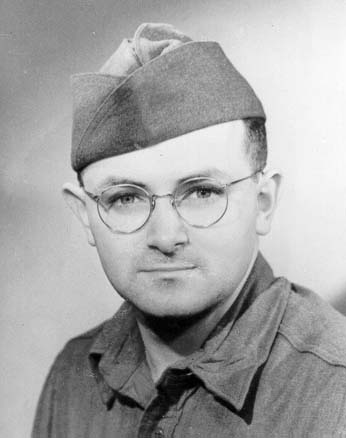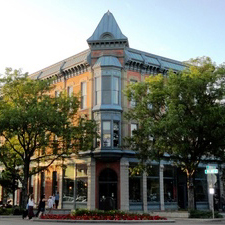Anti-Semitism in a German Church, A W.W.II Memoir
Anti-Semitism in a German Church, A W.W.II Memoir
Leo Cefkin
January 26, 1995
Interviewer: Rheba Massey
"VE day found me in the city of Worms, Germany. I was there for a day or two en route to rejoin my outfit. We had a victory parade and I got up from my hospital bed to march. It was an exhausting albeit an exciting experience. . . I reached my destination, the village of Tufles in the Tyrolean Alps east of Innsbruck . . . Tufles was a beautiful and charming place. . . We were housed (my squad) in a large farmhouse. The inhabitants (enemy civilians) were moved into the barn. There was a grandfather and grandmother, parents, three daughters and a son and their children. The daughters all had husbands in the German/Austrian armies. They didn't know whether they had survived.
The middle daughter organized a sightseeing trip for me to the village of Ruin and its church, Judenstein (Jew's stone). That was an eye-opener for me. The experience remains sharp in my memory.
Judenstein -- Jews stone -- had one wall built on an outcropping of rock. On that rock was a carving. Three figures depicting hooked-nosed Jews, the first holding a bloody knife and on that rock, a male doll of a young boy who had just been stabbed.
(The canard of blood libel states that Jesus sought out a Christian male child to sacrifice and to use his blood to make matzos for Passover. This sorry libel is discussed in the Encyclopedia Judaica under the heading "Blood libel.") I had heard of the charge of 'blood libel' since my childhood. Here it was depicted in a most astonishing way."
Cefkin was born in Rochester, New York, to Jewish parents who had immigrated from Russia. His first language was Yiddish and had learned Jewish history and literature in secular Jewish schools. During his first combat experience in December of 1944, crossing from northern Alsace into Germany, he was determined not to be captured by the Germans because he was Jewish. "We knew that things were terrible . . . We didn't know that Jews were being cremated and didn't know about Auschwitz." Cefkin did not experience discrimination in the army and when his buddies came across some former prisoners from Dachau, the men shared their rations and made some Hungarian cavalry troops dismount and give their clothes to the refugees, in Cefkin's 'honor.' Thus, seeing anti-Semitism institutionalized in this church from the 19th century was a shocking experience for Cefkin. He saw the church again after the war, traveling with his wife.
"I'd fully expected that the display of May 1945 would no longer exist 33 years later. To be sure the carving was gone, but the pathetic boy doll still rested on the rock. Judenstein had become a tourist 'attraction'. There were kiosks and souvenirs market outside of the church.
As we were leaving, Susan looked up at the ceiling and spotted three murals. In the first, the Jews had captured Andrew, the little boy. The second scene showed Andrew's parents begging for his life. In the third, Andrew is slaughtered for his blood.
I told my friend, Governor Richard Lamm about Judenstein. Dick and Dotty were to visit Innsbruck after he'd completed his stint as Governor of Colorado to take up a teaching assignment in Innsbruck. The Lamms visited Rinn and Judenstein, and they too were astounded. Dick looked into the matter and learned that the Catholic Bishop for the region wanted the Church to dismantle the display. However he was refused on the grounds that Judenstein was too good a tourist attraction to shut down."


Preserving the history of Fort Collins, Colorado & the Cache la Poudre region






